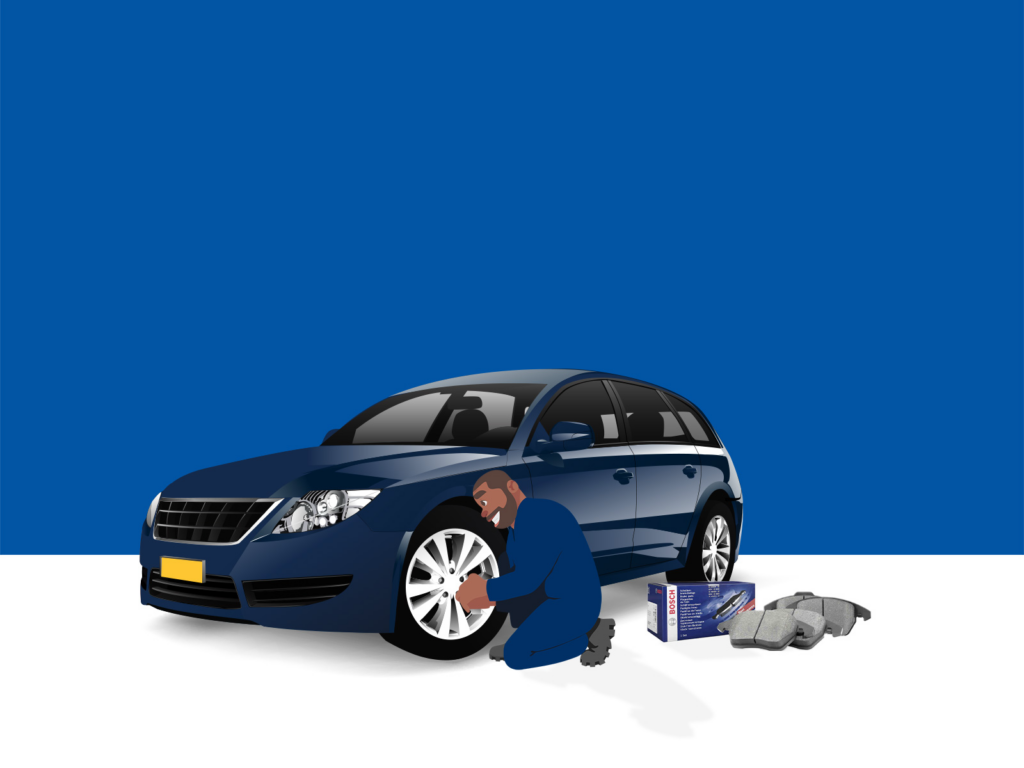If you’ve ever felt your car pull to one side or heard strange noises when braking, uneven brake wear could be the culprit. What does this mean? Instead of both brake pads on a wheel wearing down evenly, one pad wears faster than the other, or one side of a pad wears more than the other. This issue can affect your car’s safety and lead to costly repairs if not addressed on time.
So, let’s discuss the causes, signs, and simple solutions to prevent uneven brake wear and keep your vehicle in top condition.
Common Causes of Uneven Brake Wear
Sticking Brake Calipers – If a caliper fails to release properly, it can cause one brake pad to wear down faster than the others. This happens when dirt, corrosion, or a lack of lubrication prevents the caliper piston or guide pins from moving freely. As a result, the affected brake pad wears and can even lead to brake failure if left unaddressed.
Misaligned Brake Pads – Brake pads should make even contact with the rotor when applied. However, improper installation or a shifted pad can cause one side to wear down more quickly. This can lead to inconsistent braking performance and damage to other braking components.
Worn Suspension Components – Your vehicle’s suspension plays a huge role in distributing braking force evenly. Faulty shocks, bushings, or struts can cause the weight of the vehicle to shift unevenly, leading to imbalanced brake wear. If your vehicle feels unstable while braking or pulls to one side, worn suspension components may be the culprit.
Driving Habits – The way you drive significantly impacts brake wear. Frequent hard braking, sudden stops, and riding the brakes when going downhill can place excessive pressure on certain brake components. Over time, this uneven stress leads to premature wear on specific areas of the braking system.
Low-Quality Brake Pads – Not all brake pads are created equal. Cheap, low-quality pads tend to wear down faster and unevenly due to inferior materials. They may also generate excessive heat and dust, which can further damage the rotors.
Signs That Your Brakes Are Wearing Unevenly
Vibration When Braking – A shaking feeling in the brake pedal or steering wheel could indicate uneven rotor or pad wear. This is often caused by warped rotors or improperly seated brake pads.
Vehicle Pulls to One Side – If your car pulls left or right when braking, it could be due to an imbalanced brake system. This usually occurs when one brake pad is more worn than the other or when a caliper is sticking, causing uneven braking pressure.
Squeaking or Grinding Noises – Unusual brake noises, such as high-pitched squeaking or metal-on-metal grinding, can indicate uneven pad wear, rotor damage, or contamination from dirt and debris. These sounds suggest that your brake components are not wearing evenly and may need inspection or replacement.
Visible Pad Thickness Difference – If one brake pad is significantly thinner than the other, it’s a clear sign of uneven wear. Uneven pad wear can reduce braking performance and should be addressed by replacing both pads at the same time to maintain balanced braking.
How to Fix and Prevent Uneven Brake Wear
Inspect and Replace Brake Pads – Regularly check your brake pads and replace them when they show excessive or uneven wear. Always replace pads in pairs to maintain balanced braking.
Check and Lubricate Calipers – Ensure brake calipers are moving freely by cleaning and lubricating guide pins and pistons to prevent sticking. Stuck calipers can cause one pad to wear down rapidly, which is a potential safety hazard.
Align and Balance Wheels – Keeping your wheels properly aligned and balanced ensures that braking force is evenly distributed across all wheels. Misaligned wheels can create uneven pressure on the brakes, causing one side to wear down more quickly. Regular wheel alignments and balancing will help maintain even brake wear and improve overall vehicle stability.
Replace Worn Suspension Components – Address any worn shocks, bushings, or suspension parts to maintain proper braking dynamics and stability. A worn suspension can place uneven stress on the braking system, leading to premature wear on one side.
Preventing Future Brake Issues
Use Quality Brake Components – Invest in high-quality brake pads and rotors designed for your vehicle to ensure even wear and long-term performance. High-performance brake components tend to last longer and provide better resistance against wear and tear.
Adopt Smooth Braking Habits – Avoid aggressive braking and maintain a safe following distance to minimize unnecessary brake wear. Smooth and gradual braking reduces excessive stress on brake pads, leading to more even wear over time.
Regular Maintenance Checks – Have your braking system inspected during routine servicing to catch issues early and extend the life of your brakes. Routine maintenance can help identify minor issues before they become costly repairs.
Rotate Tires Regularly – Rotating tires every 8,000 to 12,000 kilometers ensures even wear and maintains balanced braking performance. Even tire wear helps distribute braking force evenly, reducing the likelihood of premature brake pad wear.
Uneven brake wear is more than just an inconvenience, it’s a serious safety risk that can compromise your ability to stop effectively. Taking proactive measures can prevent costly repairs and ensure your safety on the road. We at @thewheel, specialize in diagnosing and fixing brake issues to keep your vehicle performing at its best. If you’ve noticed any signs of uneven brake wear, don’t wait! Call us today to schedule a service appointment with us, and drive with confidence.

